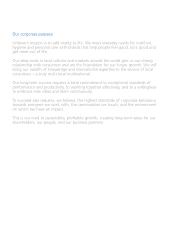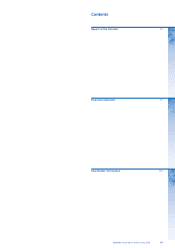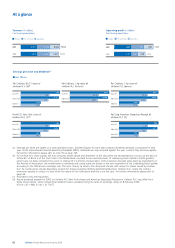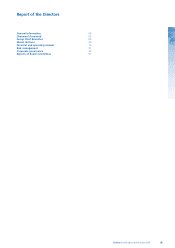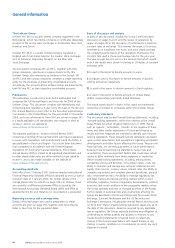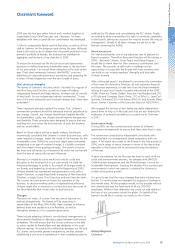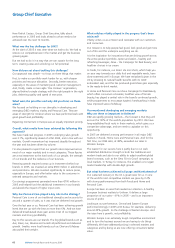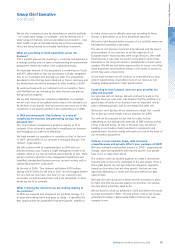Unilever 2005 Annual Report Download - page 9
Download and view the complete annual report
Please find page 9 of the 2005 Unilever annual report below. You can navigate through the pages in the report by either clicking on the pages listed below, or by using the keyword search tool below to find specific information within the annual report.Group Chief Executive
Here Patrick Cescau, Group Chief Executive, talks about
performance in 2005 and looks ahead to what needs to be
achieved over the next 12 months.
What was the key challenge for 2005?
At the start of 2005 it was clear what we had to do. We had to
restore our competitiveness in the market and get the business
growing again.
But we had to do it in a way that we can sustain for the long
term, creating value and unlocking our full potential.
How did you set about tackling this challenge?
Our approach was simple – to focus on three things that matter.
First, to make our portfolio work harder for us, with sharper
priorities and resource allocation. Secondly, better execution,
especially in the areas of marketing and customer management.
And, finally, create a more agile ‘One Unilever’ organisation,
aligned behind a single strategy, with the right people in the right
jobs, delivering quality and speed of execution.
What were the priorities and why did you focus on these
areas?
We focused on building on our strengths in developing and
emerging (D&E) markets, vitality and Personal Care. They are
areas of strength for Unilever where we have performed well, with
good growth and profitability.
Regaining momentum in Europe was an equally important priority.
Overall, what results have been achieved by following this
approach?
We have made real progress. In 2005 underlying sales growth
was 3.1%, significantly ahead of a flat 2004, and in line with our
markets. Growth momentum has improved steadily throughout
the year and has been driven by volume.
I’m also pleased to report that our growth rates improved across
most of our major markets and in most categories. These figures
are a real testament to the hard work of our people, the strength
of our brands and the resilience of our business.
Restoring growth required a step up in investment behind our
brands. In 2005, we invested an extra €500 million in advertising
and promotions. We also invested significantly to reduce prices,
especially in Europe, and offer better value to the consumer in
selected categories and markets.
Our savings programmes generated more than €700 million in
2005 and helped fund the additional investment in our brands
and absorb the impact of higher input costs.
Why has Personal Care played a key role in the strategy?
Personal Care is one of our traditional strengths and accounts for
around a quarter of sales, so it was vital we delivered real growth.
Over the last year or so, Personal Care has been achieving growth
levels that are up with the best at more than 6%. And we have
delivered broad-based share gain across most of our biggest
markets and strong profitability.
Key to this success are our brands. The big global brands such as
Axe, Dove, Lux, Rexona and Sunsilk all performed and delivered
growth. Smaller, more local brands such as Clear and Lifebuoy
also pulled their weight.
What role has vitality played in the progress that’s been
achieved?
Vitality unites us as a mission and resonates with our customers
and consumers.
Our mission is to help people feel good, look good and get more
out of life and this underpins everything we do.
It is the inspiration for innovations that are driving growth across
the entire product portfolio. Lipton and AdeS – healthy and
refreshing beverages; Dove – the Campaign for Real Beauty; and
healthier choices in ice cream.
In Foods, for instance, our Knorr Vie mini shots, which help you
on your way towards your daily fruit and vegetable needs, have
done extremely well in Europe. We have revitalised Lipton in the
US by stressing its natural health benefits with its ‘AOX’
antioxidant seal, and this has produced good share gain especially
in the ready-to-drink market.
In Home and Personal Care our Dove Campaign for Real Beauty,
which offers consumers a broader, healthier view of female
beauty, has played a central role in the brand’s continued growth,
while programmes to encourage hygienic handwashing in India
have improved sales of Lifebuoy.
You mentioned developing and emerging markets.
Why are these so important to Unilever?
D&E are rapidly growing markets – the forecast is that they will
account for 90% of the world’s population by 2010. We have
long-established local roots in these markets, which gives us a
competitive advantage, and we need to capitalise on this
opportunity.
In 2005 we delivered a strong performance in all major D&E
markets in Foods, Home Care and Personal Care. And for the
first time, our D&E sales, at 38%, exceeded our sales in
Western Europe.
The reason for our success here is partly due to our well-
established distribution strength in both the traditional and
modern trade and also to our ability to adapt excellent global
brand concepts, such as the Omo ‘Dirt is Good’ campaign, to
local markets. In Turkey, for instance, this enabled us to regain
market leadership with double-digit growth.
But what has been achieved in Europe and North America?
Our sustained recovery in the US is great news for us. In one
of the world’s most competitive markets we grew by 3.2%
with strong performances from both Foods and Home and
Personal Care.
Europe has been an area that needed our attention. A healthy
European business matters to Unilever. It delivers a large
proportion of our sales – 41% in 2005 – and is an important
source of profit.
Looking at our performance, Central and Eastern Europe
performed strongly in 2005 with Russia, for example, delivering
around 20% growth. So the challenge is Western Europe. And
the issue here is growth, not profitability.
Western Europe is an extremely tough competitive environment
and to turn the business around we are having to do things
differently. We have addressed pricing in selected markets and
categories and by doing so are now offering consumers better
value.
06 Unilever Annual Report and Accounts 2005



